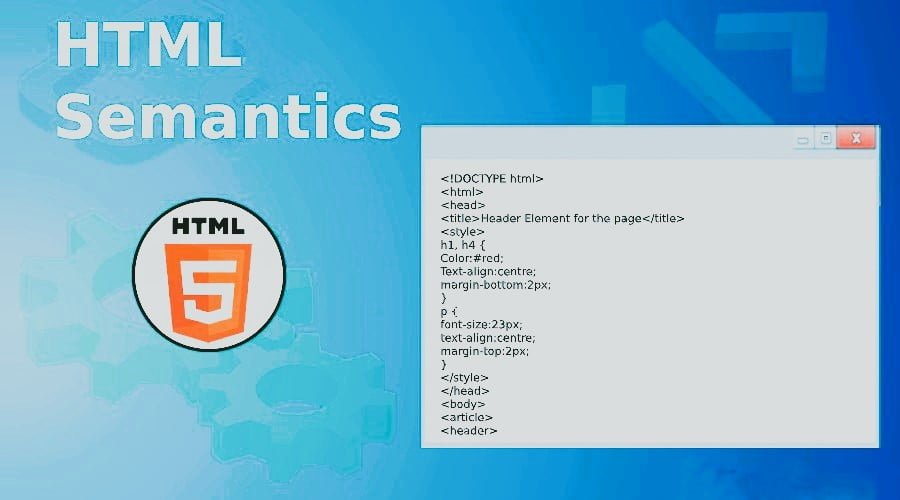HTML Tutorial
- HTML HOME
- HTML Introduction
- HTML Editors
- HTML Basics
- HTML Comments
- HTML Elements
- HTML Attributes
- HTML Headings
- HTML Paragraphs
- HTML Styles
- HTML Text Formatting
- HTML Quotations
- HTML Colors
- HTML Links
- HTML Images
- HTML Favicons: How to Add and Optimize for All Browsers
- HTML Page Title: How to Optimize Titles for SEO Success
- HTML Tables: Create & Optimize for Better Web Design | Codeezy
- HTML Lists: Types, Examples & SEO Tips for Better Structure
- HTML Block and Inline Elements
- HTML Iframes
- HTML File Paths
- HTML Layout
- HTML Computer Code Elements
- HTML Semantics
- HTML5 Semantics
- HTML Entities
- HTML Symbols
- HTML Emojis
- HTML Charsets
HTML Semantics: Enhancing Web Accessibility and SEO

HTML semantics refer to the use of HTML tags that convey the meaning and structure of web content. Unlike generic tags like <div> and <span>, semantic tags clearly define the purpose of the content they enclose, making the code more understandable for both developers and browsers. This practice not only improves the accessibility of your website but also boosts its SEO, as search engines rely on semantic elements to understand and rank your content better.
Why HTML Semantics Matter
- Improved Accessibility: Screen readers and other assistive technologies use semantic tags to interpret and present content to users with disabilities.
- Better SEO: Semantic HTML helps search engines like Google understand the structure and content of your page, leading to better indexing and potentially higher rankings.
- Cleaner Code: Using semantic tags makes your code more organized and easier to maintain.
Common Semantic HTML Elements
<header>: Represents the header section of a document or section, typically containing introductory content or navigation links.
<header>
<h1>Codeezy - Your Source for Coding Tutorials</h1>
<nav>
<ul>
<li><a href="#home">Home</a></li>
<li><a href="#tutorials">Tutorials</a></li>
<li><a href="#contact">Contact</a></li>
</ul>
</nav>
</header>
<nav>: Defines a block of navigation links, helping users and search engines understand the structure of your site.
<nav>
<ul>
<li><a href="#html">HTML</a></li>
<li><a href="#css">CSS</a></li>
<li><a href="#javascript">JavaScript</a></li>
</ul>
</nav>
<main>: Represents the main content of a document, where the primary content resides.
<main>
<article>
<h2>Understanding HTML Semantics</h2>
<p>HTML semantics are crucial for building accessible and SEO-friendly websites...</p>
</article>
</main>
<article>: Used for self-contained content that can be independently distributed or reused, like blog posts or news articles.
<article>
<h2>Introduction to HTML Semantics</h2>
<p>This article explains the importance of using semantic HTML tags...</p>
</article>
<section>: Groups related content within a page. Each section can have its own heading.
<section>
<h3>What Are Semantic Tags?</h3>
<p>Semantic tags clearly define the purpose of the content they enclose...</p>
</section>
<aside>: Contains content indirectly related to the main content, such as sidebars, callout boxes, or advertisements.
<aside>
<h4>Related Topics</h4>
<ul>
<li><a href="#seo">SEO Best Practices</a></li>
<li><a href="#accessibility">Web Accessibility</a></li>
</ul>
</aside>
<footer>: Represents the footer section of a document or section, typically containing metadata, links, or contact information.
<footer>
<p>© 2024 Codeezy. All rights reserved.</p>
<a href="#privacy">Privacy Policy</a> | <a href="#terms">Terms of Service</a>
</footer>
<figure> and <figcaption>: Used for images and their captions, providing context to the visual content.
<figure>
<img decoding="async" src="semantic-html.png" alt="Illustration of semantic HTML tags">
<figcaption>Figure 1: Example of semantic HTML elements in a web page.</figcaption>
</figure>
Example: A Semantic HTML Layout for Codeezy
<!DOCTYPE html>
<html lang="en">
<head>
<meta charset="UTF-8">
<meta name="viewport" content="width=device-width, initial-scale=1.0">
<title>HTML Semantics - Codeezy</title>
<link rel="stylesheet" href="styles.css">
</head>
<body>
<header>
<h1>Welcome to Codeezy</h1>
<nav>
<ul>
<li><a href="#tutorials">Tutorials</a></li>
<li><a href="#blog">Blog</a></li>
<li><a href="#about">About Us</a></li>
<li><a href="#contact">Contact</a></li>
</ul>
</nav>
</header>
<main>
<article>
<h2>HTML Semantics: The Key to Accessible and SEO-Friendly Websites</h2>
<section>
<h3>What Are Semantic HTML Elements?</h3>
<p>Semantic HTML elements are tags that clearly describe their meaning in a human- and machine-readable way...</p>
</section>
<section>
<h3>Why Use Semantic Tags?</h3>
<p>Using semantic tags improves the accessibility, SEO, and maintainability of your code...</p>
</section>
</article>
</main>
<aside>
<h4>Related Articles</h4>
<ul>
<li><a href="#html5">HTML5 New Features</a></li>
<li><a href="#css3">CSS3 for Beginners</a></li>
</ul>
</aside>
<footer>
<p>© 2024 Codeezy. All Rights Reserved.</p>
<a href="#privacy">Privacy Policy</a> | <a href="#terms">Terms of Service</a>
</footer>
</body>
</html>
Best Practices for Using HTML Semantics
Use the Right Tag for the Job: Always choose the most appropriate semantic tag for your content. For example, use
<header>for a page’s header and<footer>for its footer.Avoid Overusing
<div>and<span>: These tags should only be used when no semantic tag is suitable. Overuse can lead to cluttered and less maintainable code.Combine with ARIA Roles: Enhance your semantic HTML with ARIA (Accessible Rich Internet Applications) roles where necessary, particularly for dynamic content.
Validate Your HTML: Use tools like the W3C Markup Validation Service to ensure your HTML is correctly structured and adheres to standards.
Consider SEO: Semantic HTML helps search engines understand your content better, which can lead to improved ranking in search results.
Conclusion
HTML semantics is a cornerstone of modern web development. By using semantic tags, you create a more accessible, SEO-friendly, and maintainable website. Implementing these best practices will enhance the user experience and ensure your content is effectively communicated to both users and search engines.
Thank You for Visiting Codeezy.org!
We’re thrilled to have you as part of our coding community. Your engagement and support inspire us to continue providing high-quality resources and tools to enhance your web development journey. Whether you’re a beginner or an experienced coder, we hope you found valuable insights and tools here at Codeezy.
Stay connected for more tips, tutorials, and updates to help you code with ease. Thank you for choosing Codeezy.org—your growth as a developer is our motivation!
Happy coding!
